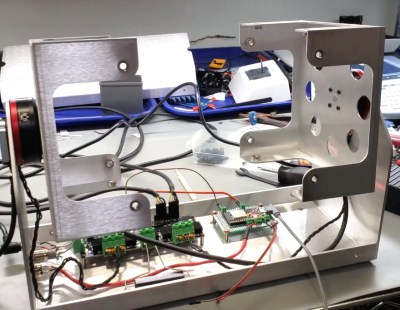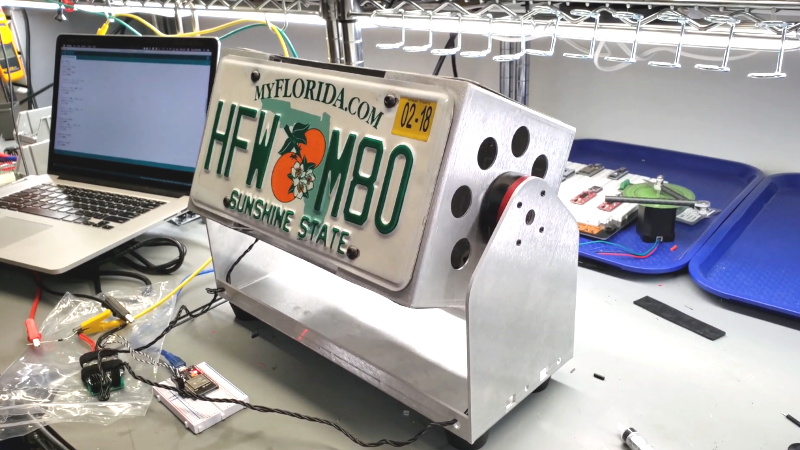Most of the projects we feature on Hackaday are built for personal use; designed to meet the needs of the person creating them. If it works for somebody else, then all the better. But occasionally we may find ourselves designing hardware for a paying customer, and as this video from [Proto G] shows, that sometimes means taking the long way around.
 The initial task he was given seemed simple enough: build a display that could spin four license plates around, and make it so the speed could be adjusted. So [Proto G] knocked a frame out of some sheet metal, and used an ESP32 to drive two RC-style electronic speed controllers (ESCs) connected to a couple of “pancake” brushless gimbal motors. Since there was no need to accurately position the license plates, it was just a matter of writing some code that would spin the motors in an aesthetically pleasing way.
The initial task he was given seemed simple enough: build a display that could spin four license plates around, and make it so the speed could be adjusted. So [Proto G] knocked a frame out of some sheet metal, and used an ESP32 to drive two RC-style electronic speed controllers (ESCs) connected to a couple of “pancake” brushless gimbal motors. Since there was no need to accurately position the license plates, it was just a matter of writing some code that would spin the motors in an aesthetically pleasing way.
Unfortunately, the customer then altered the deal. Now they wanted a stand that could stop on each license plate and linger for a bit before moving to the next one. Unfortunately, that meant the ESCs weren’t up to the task. They got dumped in favor of an ODrive motor controller, and encoders were added to the shafts so the ESP32 could keep track of the display’s position. [Proto G] says he still had to work out some kinks, such as how to keep the two motors synchronized and reduce backlash when the spinner stopped on a particular plate, but in the end we think the results look fantastic. Now if only we had some license plates we needed rotisseried…
If [Proto G] knew he needed precise positioning control from the start, he would have approached the project differently and saved himself a lot of time. But such is life when you’re working on contract.
















And let me guess… It needs to run on a dirty 12v and is controlled by a couple of remote momentary switches… Is this going on a bootlegger’s car?
It appears to be quite strongly built. Look at the gauge of that aluminum!
Shhh…. you don’t want Roscoe P Coletraine to catch on….
Useless build unless one intends to mount it on a car, but I am curious where this metal “ladder” that was used to build the desk comes from ?
In the UK this type of racking/shelving is often used in kitchens. I got my shelving (not as fancy as this, just plain shelves) at a surplus auction house. It was still quite expensive, so be warned.
In the US, look for “metro rack”. It’s used heavily in commercial kitchen and industrial settings. It’s a lot cheaper if you can find a place selling it surplus
It’s for testing and demonstrating license plate recognition software. My work bench was made with wire rack shelving from Costco.
This made me sad. I wish the silly bootlegger story was the real one.
You should consider the ethics of what you’re creating and remind yourself what it will be used for. You have a responsibility for what you create or who you collaborate with. Don’t just say “it was a client, just doing my job.” Or that if you said no somebody else would. We’re living through all sorts of problems made by engineers being unaware or unconcerned with the consequences.
Sorry to be preachy but engineers and programmers really need to stop cooperating with ubiquitous computerized surveillance. It will 100% suck for all of us someday.
nah, I work on chips that enable the next generation of image recognition for air to surface missiles, i know for fact these things are gonna kill alot of innocent people, i still sleep well at night :)
truly disgusting :/
if you were a good engineer it wouldn’t kill any innocents at all, then again you’re just a script kiddie playing the role of a real engineer.
Best of luck on your journey and I hope you find some peace in your contribution to society in your final days.
“Sorry to be preachy but engineers and programmers really need to stop cooperating with ubiquitous computerized surveillance. It will 100% suck for all of us someday.”
What kills me is that i have been seeing this sentiment become more and more common from non engineers or programmer type (i am not making any reference to you, just a comment in general) but then no one is holding executives, board members, investors, celebrities or politicians to the same standard. In the end the engineers and programmers are just people and they need to eat too, so in some circumstances you could almost consider them to be forced into this kind of work and make no mistake, that is the plan. Meanwhile the other groups of people i have mentioned who are in no way struggling make things worse for the rest of us so that we dont have the liberty to make the moral choices and they are able to accumulate more wealth and power.
Sorry, but when i have to put a roof over my head and food on my plate, i will take a job that is morally questionable to do so instead of starving or freezing to death. So maybe instead of attacking the people who dont have the luxury to make those choices and are focused on survival, we should start getting together and working on changing out the people at the levers of power.
Figured it would be as built several similar things.
Odd that they wanted it to stop tho. Ok part of the test is for cars at a barrier but if it can capture spinning at silly speeds stopped is childs play.
The remit tended to be spin as fast as possible – just below self destruct speed.
eh- two motors is overkill IMHO
The aesthetics were important to the customer and they really liked the way it looked. At the end of the day, that’s all that matters. It’s not a product that is going to be sold so reducing the price is not as important as appearance and I think it looks great like this IMHO.
This thing looks deluxe and I’m sure your customer is thrilled. Do you have any details to share about the fabrication of the metal bits?
Thank you! I manage a sheet metal manufacturing facility so I have complete access to all the equipment. The flat aluminum sheet was laser cut with a 2kW fiber laser. The flat parts were then ran through a drum sander to break all the sharp edges and put a brushed finish on the parts. After that, the parts were formed with a press brake. I’m going to start making more videos about making sheet metal parts.
In that case, install two motors, but only one needs power (for simpler control).
why use two motors at all???
Mainly because the customer and I both thought it looked more pleasant like this. Symmetry is naturally attractive.
If you just disconnected one motor you’d still have symmetry….
Then I wouldn’t be able to accelerate or stop as quickly. It was also a nice challenge to sync the motors together. It’s something I’ve never done before so I learned quite a bit in the process.
Run the second motor as a generator, and you’d have a perpetual motion machine … it can spin forever on no charge!
Hmm. Aston Martin. Try not to destroy this one Mr Bond.
Nice to see you’ve documented your involvement in building a getaway car. We can call this project “exhibit A”.
Not to get all “I could do that with a 555 and a washing machine motor” but a Geneva mechanism would have worked pretty good here.
https://en.wikipedia.org/wiki/Geneva_drive
Well, a Geneva mechanism would *look* interesting, but the approach here has exactly one moving part and no sliding joints — it’s likely far superior to a Geneva mechanism, mechanically, even though the control system is gross-but-inexpensive overkill.
But that overrun and backing up on every move smacks of a poorly-tuned controller, and gives me a twitch, it does.
Really nice and well done machine. It looks strong enough to be thrown across the room and survive. It also looks very easily serviceable in case of a problem. Ive never used a gimbal motor before, how loud is the thing?
O drive O verkill :-)
Stepper motors and a reflective end-stop to sync position every once in a while.
It’s a beautiful build as it stands, though. No question. Great work!
Get the motors in phase and simply connect the windings in parallel. They will act like one big motor.
The first thing that came to my mind was a “flip display”. Take 10-20 plates and build them on a giant flip display sort of like the 1970’s clocks.
This idea is the winner.
For the first requirements I would have chosen a brushed DC motor and some PWM speed controller with a potentiometer. No software needed. Of course when controlled stop is necessary, that gets difficult.
Brushed motors are not a good choice for something that will be running 24/7. Brushes eventually wear out and need to be replaced.